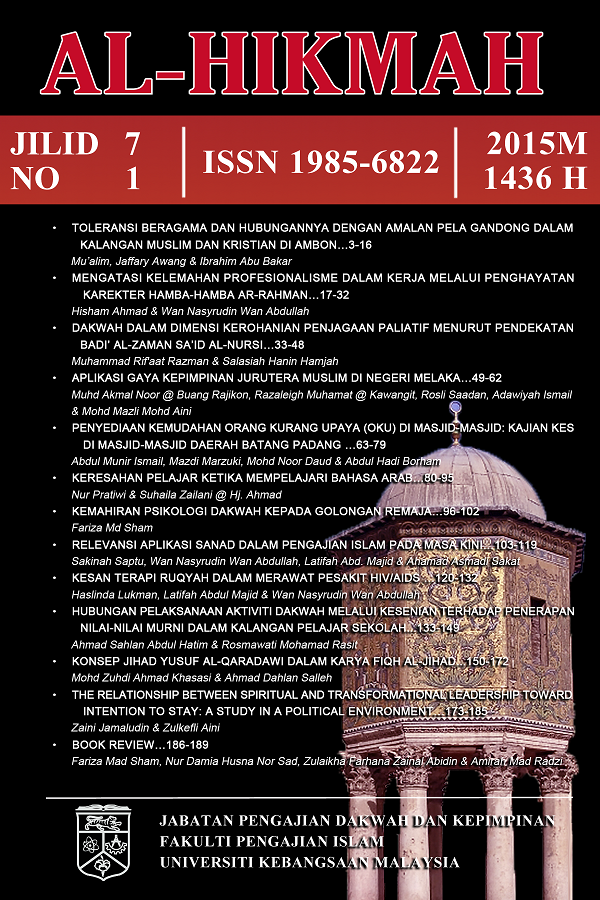THE RELEVANCE OF SANAD APPLICATION IN ISLAMIC STUDIES NOWADAYS
Relevansi Aplikasi Sanad dalam Pengajian Islam pada Masa Kini
Abstract
Recently, extreme attitude in some quarters emphasizes the sanadoccurs in Islam. The attitude during study has produced the notion that anything science related to Islam need to sanad. It also causes some people think that to be a mistake, if we study the science of religion without going through the sanadsystem. Therefore, this paper produced for the purpose of identifying the sanadin thepast and present and identify whether sanadapplications is still relevant today. This qualitative research was conducted using historical research approach. Data were collected and analyzed using content analysis. The results showed that in the past the sanadaims to (1) identify the identity of the narrators of hadith contained in the transmission path (2) assess the status of the narrators of the corner 'isand dhabit(3) determine the credibility of the narrators in the transmission whether it is received or rejected and (4) determine the validity of a hadith. Whereas during this period, the purpose of the sanad is to (1) maintain silsilah(sanad) (2) continues the tradition of previous scholars learning (3) get tabarruk(blessing) because there is a continuation of the sanad to the Prophet. Thus, the sanadapplication in Islamic studies now seen to be irrelevant because the purpose of the sanadalready materialize. In addition, the existence of sanadunimportant because the narrators today can not be examined the credibility.
References
Abu Ghuddah, cAbd al-Fattah. 1992. al-Isnad min al-Din wa Safhah Musyrifah min Tarikh Samaci al-Hadith cinda al-Muhadithin. Bayrut:Dar al-Qalam.
Abu Zahwu, Muhammad Muhammad. 1984. al-Hadith wa al-Muhaddithun. al-Riyad: Syarikah al-Tibacah al-cArabiyyah al-Sacuudiyyah.
Ahamad Asmadi Sakat. 2014. Pendapat Ibn Salah tentang Sanad pada zaman ini. Temubual, 25 April.
al-Acza’i, Muhammad Mustafa. 1992. Dirasat fi al-Hadith al-Nabawiyy wa tarikh tadwinihi. Jil. 2.,Beirut: al-Maktab al-Islamiyy.
al-Aczami, Muhammad Mustafa. 2003.The History of the Quranic Text from revelation to compilation A comparative study with the old testament and New Testament. Leicester: UK Islamic Academy.
al-cUmari, Akram Diya. 1984. Buhuth Fi Tarikh al-Sunnah al-Musyarrafah. al-Madinah al-Munawwarah: Maktabah al-cUlum wa al-Hikam.
al-Durar al-Saniyyah. t.th. al-Mausul’ah al-Hadithiah Taisir al-Wusul Ila Ahadith al-Rasul s.a.w. http://www.dorar.net/enc/hadis [15 Mei 2012].
Ali Tantawi. .2006. Pendapatku Tentang Sanad. http://www.al-ahkam.net/home/content/pendapatku-tentang-sanad [10April 2012]
al-Khatib al-Baghdadi. 1975. al-Rihlah fiTalab al-Hadith. Beirut: Dar al-Kutub al-cIlmiyyah.
al-Khatib al-Baghdadi. 1983. al-Jamic li Akhlaq al-Rawi wa Adab al-Samic. Jil. 2. Riyad: Maktabah al-Macarif.
al-Ramahurmuzi, al-Hasan ibn cAbd al-Rahman.1971. Al-Muhaddith al-Fasil Baina al-Rawi wa al-Waci. Beirut:Dar al-Fikr.
al-Sibaci, Mustafa. 2003. al-Sunnah wa Makanatuhafi al-Tasyric. Bayrut: Dar al-Warraq.
al-Zahrani, Muhammad ibn Matr. 2005. Tadwin al-Sunnah al-Nabawiyyah Nasy’atuhu wa Tatawwaruhu. al-Riyad: Maktabah Dar al-Minhaj.
al-Zahrani, Muhammad ibn Matr. 2010.cIlm al-Rijal Nasy’atuhu wa Tatawwaruhu min al-Qurn al-Awwal ila Nihayah al-Qurn al-Tasic. al-Riyad: Maktabah Dar al-Minhaj.
Farhah Zaidar Mohamed Ramli, Latifah Abdul Majid & Mohd Arif Nazri. 2013. Penerokaan Talaqqi bersanad (TB) dalam Pengajian Hadis di Malaysia. Islamiyyat 35(2): 67 – 76.
Firanda Andirja Abidin. 2012. Ketika Sang Habib dikritik. t.tp: Naasirussunnah.
Graham, A.William. 1993. Traditionalism in Islam.The Journal of Interdisciplinary History 23(3):495-522 http://www.jstor.org/stable/206100 [29 Mac 2012].
Ibn Jamacah, Muhammad ibn Ibrahim, 1986. Al-Mihal al-Rawi fi Mukhtasar cUlum al-Hadith.Beirut: Dar al-Fikr.
Ibn Salah. 1995. Muqaddimah ibn Salah. Beirut: Dar al-Kutub al-cIlmiyyah.
Khafidz Soroni. 2014. Pengajian Bersanad Tetap Relevan. Q&A April: 50-52.
Khalid Marghub.2009. Makanah al-Ijazah cinda al-Muhaddithin baina al-Ifrat wa al-Tafrit al-Hasilin fiha min bacdi al-Muhaddithin. t.tp: al-Ummah.
Mahmud Tahhan. 1996. Taisir Mustalah al-Hadith, al-Riyad: Maktabah al-Macarif fi al-Nasyr wa al-Tauzic.
Mohd Asri Yusof. 2012. Apakah Pada Hari Ini Pengajian Bersanad Menjadi Satu Kemestian? Video. http://youtu.be/YXRgTF5AwG8 [30September 2014].
Mohd Asri Zainal Abidin. 2011. Hukum Mengaji Tanpa Sanad Sendiri.http://drmaza.com/home/?p=1411 [30 Mac 2012].
Muhammad cAjjajal-Khatib. 1988. al-Sunnah Qabla al-Tadwin. al-Qahirah: Maktabah Wahbah.
Muhammad cAjjajal-Khatib. 1989. Usul al-Hadith cUlumuhu wa Mustalahuhu. Bayrut: Dar al-Fikr.
Muhammad Zubayr Siddiqi.1993. Hadith Literature: Its Origin, Development & Special Features., Cambridge: The Islamic texts society.
Munzir. 2007. Paham Salafy (Wahaby). http://majelisrasulullah.org/index.php?option=com_simpleboard&Itemid=&func=view&catid=7&id=9654#9654) [30 September 2014].
Munzir. 2011. Sanad & Berdakwah. http://majelisrasulullah.org/index.php?option=com_simpleboard&Itemid=&func=view&catid=9&id=26683#26683 [30 September 2014].
Muslim ibn al-Hajjaj al-Qusyairyy al-Naisaburiyy. 2001. Sahih Muslim. Bayrut: Dar al-Kutub al-cIlmiyyah.
Nur al-Din cItr, 1997. Manhaj al-Naqdi ficUlum al-Hadith. Damsyiq: Dar al-Fikr.
Raja Ahmad Mukhlis, 2011b. Ilmu Warisan Nabawi Merentasi Zaman (2): As-Sawad al-A’zhom dalam Tradisi Keilmuan Islam. http://mukhlis101.multiply.com/journal/item/325 [22 Mac 2012].
Raja Ahmad Mukhlis. 2011a. Ilmu Warisan Nabawi Merentasi Zaman (1): Tradisi Pengajian Ilmu Agama dalam Amalan Ulama. http://mukhlis101.multiply.com/journal/item326 [22 Mac 2012].
Raja Ahmad Mukhlis. 2011c. Ilmu Warisan Nabawi Merentas Zaman (3): al-Turath al-Islami dalam Tradisi Keilmuan Islam, http://mukhlis101.multiply.com/journal/item324 [22 Mac 2012].
Authors retain copyright and grant the journal right of first publication with the work simultaneously licensed under a Creative Commons Attribution License (CC BY-SA 4.0) that allows others to share the work with an acknowledgement of the work's authorship and initial publication in this journal.





